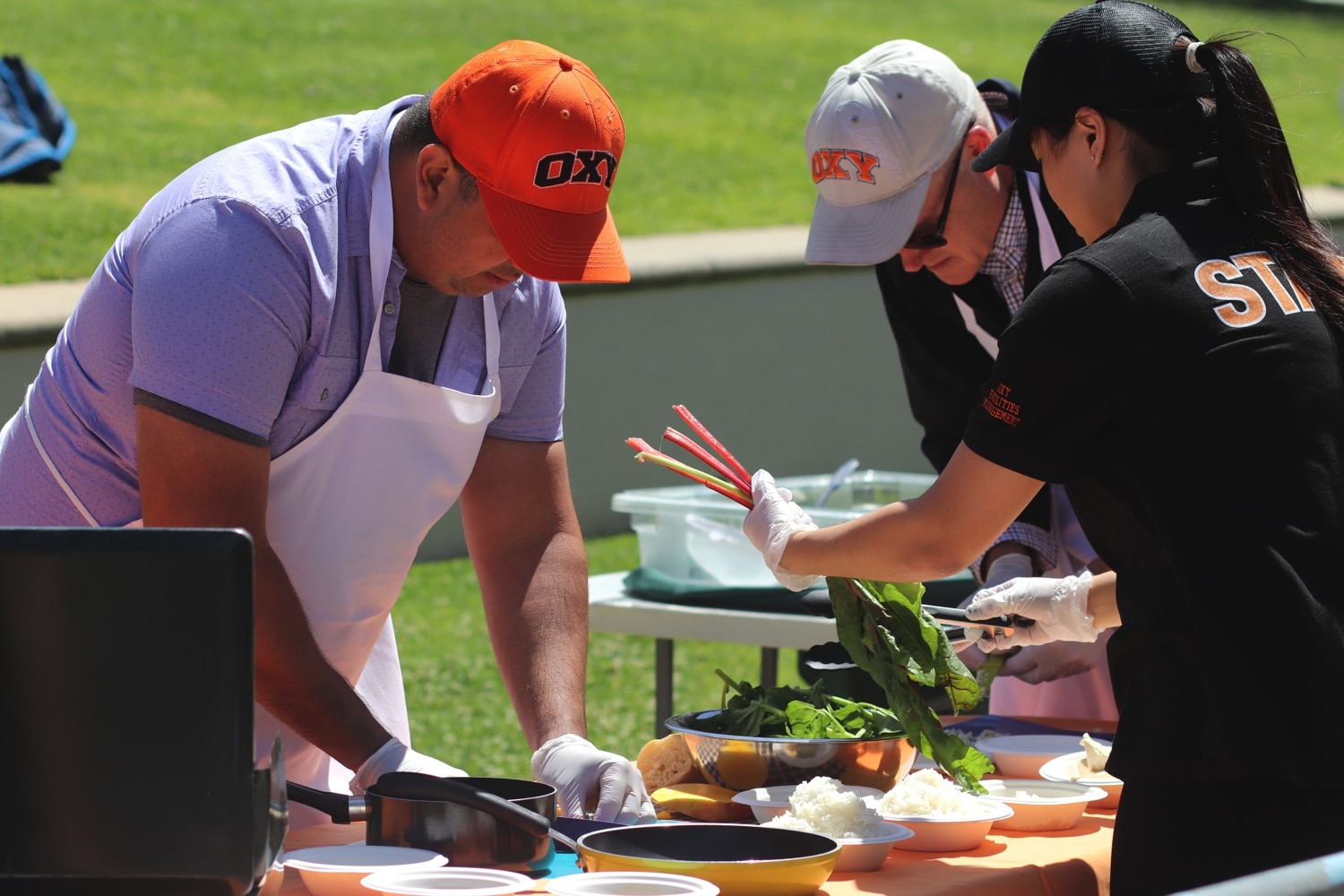Sautéed carrot and cucumber Banh-mi and Cajun potato latkes with mango aioli are dishes typically found exclusively on the menus of five-star restaurants, not in the Johnson Student Center (JSC) quad. But Occidental students and staff creatively crafted these dishes on camp stoves April 12 as part of the fourth Iron Chef competition, hosted by the Food Energy and Sustainability Team (FEAST), Campus Dining and Sustainability Fund.
Spectators lined the JSC quad to watch six teams — Jalapeño Business, Nutritional Yeet, Three Rats One Hat, Team Fire Alarm, Burnt Toast and last year’s winners Orange is the New Snack — brave the windy outdoor conditions to create two vegetarian or vegan dishes: a starter and a sauté. The teams were required to incorporate a secret ingredient — New Zealand spinach from FEAST garden — in one of the dishes.
Orange is the New Snack returned to defend their 2017 victory, and last year’s runners-up, Chop It Like It’s Hot, competed this year as Three Rats One Hat. After one hour of cooking, Three Rats One Hat emerged from their outdoor kitchen as winners of the 2018 Iron Chef competition. Jalapeño Business placed second and Burnt Toast placed third in the competition.
According to FEAST director Diego Zapata (junior), New Zealand spinach is actually more closely related to succulent plants than spinach and continues to grow in hotter Southern California temperatures. The spinach is grainy and difficult to work with because it must be blanched to reduce the amount of oxalates, which can contribute to indigestion in large quantities.
“You have to know how to handle [New Zealand spinach], so in terms of the actual Iron Chef competitions they always strive for something that is novel or weird to work with,” Zapata said.
Campus Dining Sustainability Intern and Sustainability Fund Secretary Sammy Herdman said that all the ingredients used in the competition were from the FEAST garden or they were the organic, sustainability sourced food used by the Marketplace. According to Herdman, the organizers used these ingredients to encourage sustainable food use and community engagement as a part of Earth Month.
“A lot of the time, the people you have coming to these Earth Month activities and Food Justice activities, which are in October, are students who are already interested or passionate about these issues,” Herdman said.” By making [the competition] into something more than just a talk or a workshop about sustainability, [it] has a much wider scope of the people that participate,” Herdman said.
The competition judges were sociology professor John Lang, who teaches Sociology of Food and studies the intersections of food, risk, consumption, consumers and trust; Celeste Padula (sophomore), FEAST nursery operations manager; Courtney Robertson, associate director of strategic initiatives and faculty support and Diep Tran, owner and founder of the Highland Park Vietnamese restaurant Good Girl Dinette.
The judges scored each team’s starter and sauté dish on a 1–10 scale for taste, use of ingredients and presentation, according to Sustainability Coordinator Jenny Low. Points would have been subtracted from the score for health and safety violations, but no infractions occurred this year.
Osa Goldfarb (junior) and Eva Jahanshir (junior) returned for their second year, and Noel Jameson (junior) joined Three Rats One Hat this year. They received first place in the starter category for their crostini with butter, rosemary, beets, goat cheese and yellow mustard and second place in the sauté category for their confetti rice with fried tofu and mango chutney.
Jalapeño Business worked quickly and completed their starter and sauté dish 15 minutes early. While they received second place in the starter category, they were not able to beat Three Rats One Hat.
According to Jahanshir, before the competition Three Rats One Hat had a brainstorming session to prepare for the competition, which set them on the path to victory.
“Noel’s a new team member this year and he had some really good ideas, especially for plating, he had the idea for the main dish,” Jahanshir said. “We just meshed really well this year.”
Tran said that she enjoyed the teams’ use of the secret ingredient and he noticed that Three Hats One Hat found the most success using a lot of New Zealand spinach in their starter dish.
“The dish I liked the best used the most of it, like in a crostini, they cooked it down so you can really taste the spinach,” Tran said.
Zapata was a student judge last year and said that the food along with the event itself has since improved.
“I would have paid top dollar for the dishes,” Zapata said.
Zapata said that this year more people were asking the contestants questions about their cooking and sampling the finished products.
“It became more of a community-oriented event,” Zapata said.
The competitors knew they would be faced with a secret ingredient, but they did not know that they would have to contend with heavy gusts of wind as they cooked. Zapata said that ingredients and plates were flying away during the cooking process, but the uncontrollable natural elements made the competition more lively.
“I think that’s the nature of the Iron Chef competition. It’s very holistic, you never know what will happen during the competition. It’s anyone’s game and you just have to go through with it,” Zapata said.
Three Rats One Hat said that the wind was difficult to work in, but their friendship helped the team manage the circumstances.
“They’re my best friends, so we worked it out,” Jahanshir said.
![]()



































